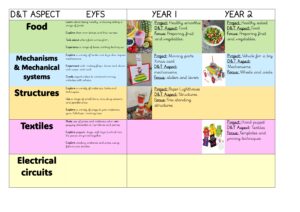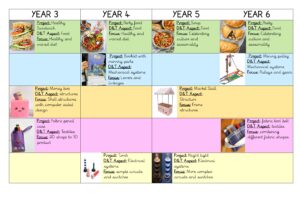Design Technology
“Technology makes possibilities and design makes solutions.”
“Design and Technology is where maths and science combine to turn bright ideas into useful products. Creativity is allowing yourself to make mistakes. Design is knowing which ones to keep.’
James Dyson
Intent
Our ambitious curriculum develops the ability to evaluate, design and build creative and imaginative products for a range of purposes. We ensure that our teaching is founded on principles that challenge the pupils to make innovative design decisions, reflect upon the needs of the user and the final intended purpose of the product.
It is our intention to equip pupils with the skills, vocabulary and technical knowledge to increase/improve the functionality of the child’s product and provide them with the scope and opportunity to be original and innovative with their choices.
Through our curriculum, we aim to inspire and enthuse our learners to think about and design high quality products that are authentic and meaningful and gain an understanding of the relevance DT has in our modern technological world.
Our teaching helps children to gain an appreciation of the impact that past and present inventors, engineers and designers have on our lives today. This will allow our children to have a much more critical approach to their own designs and creations.
Implementation
The sequence of learning of our DT projects encompasses the full design process that would accompany any adult creation. In KS1 planning starts with research into what the product is and the relevance of those products in the home and school environment. As children progress through the school, they learn about how products support our lives locally, nationally, and globally to influence their own creations. In later years, children learn about the impact of an inventor linked to the learning intention.
Teaching examines how existing and related products are constructed.
Children use that learning to develop the technical skills and knowledge needed to build their product, ensuring it functions as required and intended.
They will develop design criteria and specifications and create technical diagrams and annotated drawings to develop their product and support them through the build process.
There are many opportunities for practical learning. Children have access to a range of resources and equipment and are taught to select the most appropriate tools needed to build their product. They will be encouraged to test, evaluate, and reflect upon the effectiveness of their product; considering the original idea, specification, and purpose to learn from their successes and difficulties.
At a glance
• National curriculum guiding principles inform year group subject mapping documents
• DT is mapped across year groups in small sequential steps and end points identified (to know, do and experience)
• Treloweth ½ term Progression Documents plot sequential small steps
• Each year group has 3 end point statements to meet; this is mapped to reflect their topic where possible every other half term
• Lessons activate prior knowledge, introduce, use and apply specific vocabulary, learning is demonstrated practically
• Information for parents can be found in ½ term overviews
• Examples of work can be found on class website pages newsletters and display
• Links to other subjects include: history, science, maths, art, English
Please click on the Pdfs below for more information:


